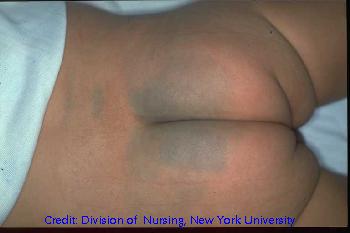
Example of Mongolian Spot
| WHAT ARE THEY?
Mongolian Blue Spots are flat birthmarks with wavy borders and irregular shapes, common among people of Asian, East Indian, African, and Latino heritage. They may be seen in about 10% of Caucasians to over 90% of African Americans. Bluish gray to deep brown to black skin markings, they often appear on the base of the spine, on the buttocks and back and even sometimes on the ankles or wrists. Mongolian spots may cover a large area of the back. The pigmented area has large concentrations of skin cells called melanocytes, with normal skin texture. They commonly appear at birth or shortly after birth and may look like bruises. |

Example of Mongolian Spot
| WHAT TO DO ABOUT THEM?
Mongolian spots are benign skin markings, and are not associated with any illnesses, complications or risk factors. There is no known prevention and they generally fade in a few years and disappear by puberty. Though occasionally they persist into adulthood, there is no need for treatment. DOCUMENTATION Because Mongolian spots can be easily mistaken for bruises, particularly by well-meaning white people who have no experience with them, they have triggered accusations of child abuse against some adoptive parents. For this reason, it is important to be sure that both your child's pediatrician and the caseworker who completes your post-adoption work record information on the presence of Mongolian spots into their records. You can assist in the documentation of this information by taking snapshots of the spots and providing prints to be included in your child's files. Since you cannot take for granted that everyone will know what Mongolian spots are, it is good advice to have their presence recorded from the start. Reprinted with permission from An Insider's Guide to Transracial Adoption by Gail Steinberg and Beth Hall of PACT, An Adoption Alliance, 3450 Sacramento Suite 239, San Francisco, CA 94118; phone (415) 221-6957; website: http://www.pactadopt.org. This article may be reprinted by other groups without permission with the source information reprinted as above. |
